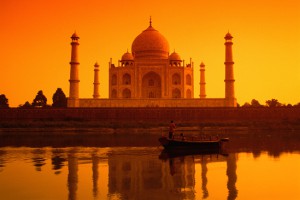Globus
Eclectic temples and imposing forts. Pristine wildlife refuges and lively metropolises. Pink cities and golden triangles. Fairytale monuments and tantalizing cuisine. There’s no better introduction to India than this incredible Independence by Globus journey. Tour bustling Mumbai, witness its tiffin lunch box delivery system, and visit the former residence of Mahatma Gandhi. You’ll also explore the Elephanta Caves, a UNESCO World Heritage Site. Next, travel to Varanasi, the holiest of Hindu pilgrim cities, to witness the striking Ganga Aarti (spiritual worship) on the ghats (steps) leading down to the sacred Ganges River. In the capital city of Delhi, enjoy a rickshaw ride through the famed Chandni Chowk bazaar-a market that’s been around for more than three centuries. Spend time here shopping for exotic spices, gold, fabrics, and a host of trinkets and souvenirs. You’ll also visit Gurudwara Bangla Sahib, the largest Sikh house of worship in Delhi; and explores the lavish, 16th-century garden-tomb of Mughal Emperor Humayun (a precursor to the Taj Mahal). Southeast in Agra, be sure your cameras fully charged for your private guided sightseeing tour that begins with a truly unforgettable sunrise visit to the incomparable Taj Mahal. Then, visit the ancient red sandstone Agra Fort, which guarded the imperial city of the Moghul rulers. In the "Pink City" of Jaipur, your private sightseeing takes you to the amazing Amber Fort with the glittering walls and ceilings in the Sheesh Mahal (Mirror Palace), the City Palace, and the fascinating bigger-than-life Jantar Mantar astronomical observatories. Enjoy the I-time you crave with free time and optional excursions to experience this fascinating destination in your own way.
Featured Destinations
Jaipur
Jaipur
Jaipur, popularly known as the Pink City, was founded in 1727 AD by one of the greatest rulers of the Kachhawaha clan, the astronomer king Sawai Jai Singh. The pink color was used at the time of making to create an impression of red sandstone buildings of Mughal cities - and repainted in 1876, during the visit of the Prince of Wales. The city is best explored on foot and the adventurous visitor willing to go into the inner lanes can discover a whole new world not visible to the tourist-in-a-hurry.
|
Destination Guide
|
Agra
Agra
In the mid 16th century and early 17th century, Agra witnessed a frenzied building activity and it was during this time when the symbol of love Taj Mahal was built. The buildings made during this era were purely in the contemporary Mughal style and of very high quality which is still reflected in what ever monuments remain in Agra. The narrow lanes of Agra filled with aroma of Mughlai cuisine, the craftsman who are busy creating masterpieces with their skill all remind of the Mughal royalty which this city had once experienced. Today whatever remains, has become a major tourist attraction which has taken Agra again to the heights of glory but this time as a major tourist destination of India. Main shopping areas include Taj Mahal complex, Kinari Bazaar, Raja Mandi, Sadar Bazaar. the Gangotri at Taj Mahal Complex and the Up Handlooms, UPICA at the Sanjay place are two UP Government emporiums.
|
Destination Guide
|
Delhi (New Delhi)
Delhi (New Delhi)
Delhi is the third largest city and consists of Old Delhi and New Delhi. Old Delhi was the capital of India Between 17th and 19th centuries and now contains many mosques, monuments and forts relating to India's muslim history. The other Delhi is the imperial city created as the capital of India by the British. In addition to its historic interest and role as government center, Delhi is a major travel gateway. The architectural designs and sophistication that buildings in Delhi like Parliament House, Rashtrapati Bhavan, India Gate, Connaught Place and various administrative buildings like the South and North blocks along the breathtaking view available from Raj Path, show British influence. Modern Delhi has a cosmopolitan culture that nurtures festivals of all faiths and religions. Theatre, drama and entertainment of all sorts including discotheques are there.
|
Destination Guide
|
Varanasi
Varanasi
Picturesquely situated on the crescent shaped left bank of the holy Ganga, Varanasi, one of the ancient seats of learning in India, is said to be a compound of the names of two streams, the Varuna and the Assi, which still flow in the north and south of the city respectively. This name seems to have been corrupted, in medieval times to Banaras, which was in use till May 24, 1956 when it was changed to Varanasi, by an order of the Government of India. Varanasi is probably one of the most ancient living cities in India. From time immemorial it has been a great religious center for Hindus and one of their most sacred places of pilgrimage, being visited by millions of people every year. At a distance of 12 km from Varanasi lies Sarnath, where Lord Buddha preached his first sermon. Here he revealed the eight fold path that leads to the attainment of inner peace, Enlightment and Ultimate Nirvana.
|
Destination Guide
|
Mumbai
Mumbai
About 300 years ago, the area of Bombay was nothing more than seven islands occupied by small fishing settlements. Today this bustling city offers a seemingly endless array of sights and cultural activities. Mumbai is the glamour of Bollywood cinema, cricket on the maidans on weekends, bhelpuri on the beach at Chowpatty and red double-decker buses. It is also the infamous cages of the red-light district, Asia's largest slums, communalist politics and powerful mafia dons. This pungent drama is played out against a Victorian townscape more reminiscent of a prosperous 19th-century English industrial city than anything you'd expect to find on the edge of the Arabian Sea. Mumbai has vital streetlife, India's best nightlife, and more bazaars than a visitor could ever explore.
|
Destination Guide
|
View Full Itinerary
Valid Date Ranges






